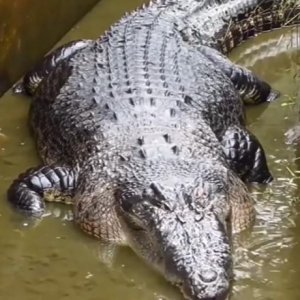Croc and Crane Estuary Experts
Fascination with Crocodiles and Cranes provides the name and the content is along the lines of the beauty and the terror in Nature.
ESTUARY EXPERTS
ESTUARY EXPERTS
Monday, December 11, 2023
Sunday, October 1, 2023
Saturday, March 18, 2023
Hippos take on crocodiles for best sunbathing spot | Serengeti - BBC
Hippos take on crocodiles for best sunbathing spot
https://youtu.be/Jftq8uJ5lQ8
Thursday, August 25, 2022
Thursday, August 11, 2022
Wednesday, March 30, 2022
GREY HERON PLUS TWO TURTLES
Here’s a photo from Sean Kerrigan of two slider terrapins basking on logs with a grey heron. Report your sightings: http://turtletally.co.uk
Friday, September 3, 2021
You can't change what you refuse to confront.
"No matter how bad a state of mind you may get into, if you keep strong and hold out, eventually the floating clouds must vanish and the withering wind must cease.”
- Dogan Zenji
The mind has exactly the same power as the hands: not merely to grasp the world, but to change it.
- Colin Wilson
You can't change what you refuse to confront.
"Civilization is a hopeless race to discover remedies for the evils it produces." Jean-Jacques Rousseau
Even though our society doesn’t emphasize it, the most crucial use of knowledge and education is to understand the importance of more wholesome action and disciplining the mind—essentially the development of a good heart.
Dalai Lama
You can't change what you refuse to confront.
"Civilization is a hopeless race to discover remedies for the evils it produces." Jean-Jacques Rousseau
Even though our society doesn’t emphasize it, the most crucial use of knowledge and education is to understand the importance of more wholesome action and disciplining the mind—essentially the development of a good heart.
Dalai Lama
Thursday, August 19, 2021
Monday, August 9, 2021
Monday, May 25, 2020
Saturn was An alligator who survived WWII
Saturn the Alligator
Alligator called Saturn who survived World War Two in Berlin and
was wrongly rumoured to have belonged to Adolf Hitler dies at
Moscow Zoo aged 84
Will Stewart for MailOnline
An alligator who survived WWII in Berlin and was rumoured to have belonged to Hitler has died at Moscow Zoo at the age of 84. Found by British soldiers in Berlin after WWll & handed to the Red Army. Called Saturn, he has lived at Moscow Zoo since 1946.
Known to have been a pre-war star attraction at Berlin Zoo in Nazi Germany, the story also circulated that the reptile had been in Hitler's personal pet collection, as suggested by famous Russian writer Boris Akunin.
'Almost immediately after the arrival of the animal [in Russia], the myth appeared that it was supposedly in Hitler's collection, and not in the Berlin zoo,' Interfax news agency reported. Despite being a widespread rumour, there is no proof to support the claim.
Dmitry Vasilyev, a Moscow zoo veterinarian, said there was no doubt that Hitler admired the alligator, who was a popular attraction at the zoo in Berlin before the war. Saturn lived until the 75th anniversary of Hitler's defeat earlier this month. The alligator was born in the wild in Mississippi in 1936 before being caught and shipped to Berlin Zoo
Provided by Daily Mail Pictured: Berlin Zoo in the aftermath of the battle of Berlin, when Russian forces stormed the German capital There is mystery over the Saturn's whereabouts after Berlin was bombed from November 1943. He was eventually found by British soldiers three years later. One theory is he 'hid in basements, dark corners and sewage drains', another that he was in the menagerie of a senior Nazi.
In the early 1990s, Saturn witnessed the Soviet collapse and reports said he had 'tears in his eyes' when tanks shot the nearby Russian parliament because it 'reminded him of the bombing of Berlin'. Saturn was the longest resident of Moscow Zoo, several times cheating death. A slab of concrete fell from his the alligator's aquarium in the 1980s narrowly missing him.
A story by a Russian writer suggested that Saturn was one of the animals in Hitler's private pet collection. A cruel visitor threw a stone at his head - requiring months of medical care. When a new aquarium was built, Saturn went on hunger strike for four months in protest. He did the same in 2010 - for a year - but eventually started eating again.
An obituary by Moscow Zoo said: 'Saturn is a whole era for us. This is not the slightest exaggeration. He arrived after the Victory (in the war) - and met its 75th anniversary. 'It is a great happiness that each of us could look into his eyes. He saw many of us as children. We hope we did not disappoint him.'
https://www.msn.com/en-za/news/world/alligator-called-saturn-who-survived-world-war-two-in-berlin-and-was-wrongly-rumoured-to-have-belonged-to-adolf-hitler-dies-at-moscow-zoo-aged-84/ar-BB14vC9D?li=BBqg6Q6&ocid=iehp
Monday, February 24, 2020
Mercury contamination in American alligators fades with age, and scientists aren’t sure why.
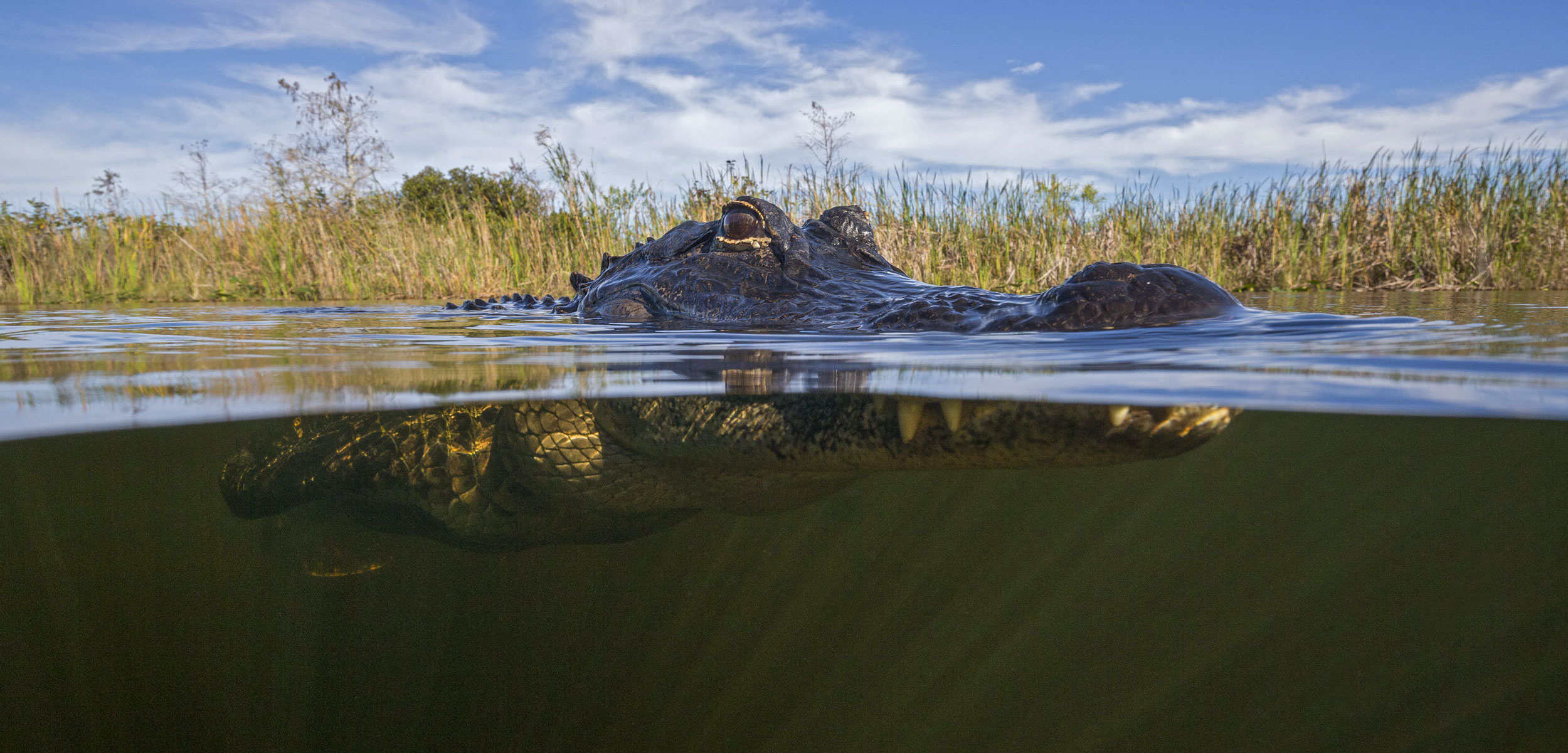
For Older Alligators, Mercury Is in Retrograde
Mercury contamination in American alligators fades with age, and scientists aren’t sure why.
Authored by Jess Mackie
February 13, 2020 | 600 words, about 3 minutes
South Carolina’s low country—a 2,000-square-kilometer swath of coastal marsh and swampland—is gator country and has been for millions of years. That landscape has changed in recent decades with industrial development. Emissions from coal-burning power plants and other sources of pollution, like a large paper mill in the city of Georgetown, have contaminated the area with heavy metals.
“We’re lousy with mercury around here,” says Jay Butfiloski, a wildlife biologist with South Carolina’s Department of Natural Resources, referring to how widespread the pollutant is.
In the low country, as with other wetlands, bacteria living in the oxygen-starved soil convert the heavy metal deposited onto the landscape into methylmercury, a potent neurotoxin. Methylmercury accumulates up the food chain, concentrating in the bodies of plants and animals over time. That means American alligators—apex predators that can live up to 50 years in the wild—can serve as proverbial canaries in the coal mine. Though alligators seem unaffected by the pollutant, measuring the concentrations of mercury in their bodies can give scientists a rough assessment of the level of contamination in the environment.
There’s another good reason scientists monitor mercury concentrations in the reptile: fried, grilled, or boiled in a stew, wild alligator is on the menu for hunters brave enough to wrangle and cook one.
In South Carolina, eating wild alligator comes with a warning: healthy adults should consume it no more than once a week, and those who are particularly sensitive to mercury’s ill effects, such as pregnant women or young children, should eat it no more than once a month. (Those advisories don’t transfer to farmed alligator—the kind sold in restaurants and grocery stores.)
But because mercury accumulates over time, not all alligators pose the same risk when eaten—theoretically, older alligators contain the most mercury.
The trouble is, until recently, scientists had assumed alligators, like some reptiles, never stop growing, meaning the largest animals are also the oldest. In 2016, that perception was disproved by scientists who have been capturing and studying wild alligators in Georgetown’s Tom Yawkey Wildlife Center since 1979. By knowing each alligator’s approximate age, they found the reptiles stopped growing around middle age: 31 for females and 43 for males.
Once age and size were teased apart, Abby Lawson, a population ecologist at Alabama’s Auburn University, used the same decades-long data set to identify patterns between age and mercury concentration. The research led her to a puzzling finding: old alligators have less mercury in their bodies than middle-aged alligators. Somehow, the heavy metal stopped accumulating and then began to decline.
Lawson has a few hypotheses on why this is happening. She says the alligators could be offloading the contaminant through their skin or claws, which they lose throughout their lives. It’s also possible their diet changes as they age. Older alligators may consume less, or, as Butfiloski suggests, switch from fish and other aquatic prey to terrestrial mammals that harbor less mercury such as raccoons, deer, and wild hogs.
Though it remains unclear why mercury contamination in alligators peaks and then dips, Lawson says alligator meat, which has the texture of chicken and the flavor of fish, is enough of a novelty that hunters likely aren’t eating it often enough to be at risk of mercury poisoning.
Still, precaution should be taken since mercury levels vary geographically, Lawson says. For those willing to take a risk to indulge in some unconventional meat, stick to the oldest alligators. (Juveniles, the other age class that would be safer to consume, can’t legally be harvested in South Carolina.) But since elderly and middle-aged alligators can’t be distinguished by size, scientists will need to work out some other way of easily telling them apart—only then could South Carolina’s wild alligator consumption guidelines potentially be tweaked.
Wednesday, February 19, 2020
Witness to Steve Irwin's Death
SmarterEveryDay
Dr. Seymour "Jelly Dude from Nemo Land" talks about how spending a week with Steve Irwin affected his life.
Tweet: http://bit.ly/IrwinTWT FB: http://bit.ly/IrwinFB
Visit Steve Irwin's Legacy: http://www.australiazoo.com.au/
More info! ⇊ Click below for more links! ⇊ Here's more info on Jamie (He told me not to call him Dr. Seymour): https://research.jcu.edu.au/portfolio... Dr. Seymour teaches at James Cook University Official comment thread on Reddit here: http://bit.ly/IrwinComments (I participate in this discussion) A huge thanks to Dr. Jamie Seymour, a world renouned venom biologist at James Cook University. He's a top notch guy who helped me open my eyes to the wonders of the ocean. https://en.wikipedia.org/wiki/Jamie_S...
Also, the beautiful Underwater clip of Dr. Seymour and I watching the anemonefish was taken by "Shark Dude" Richard Fitzpatrick. Richard is the man.
Tuesday, January 21, 2020
Hatchling Gharials
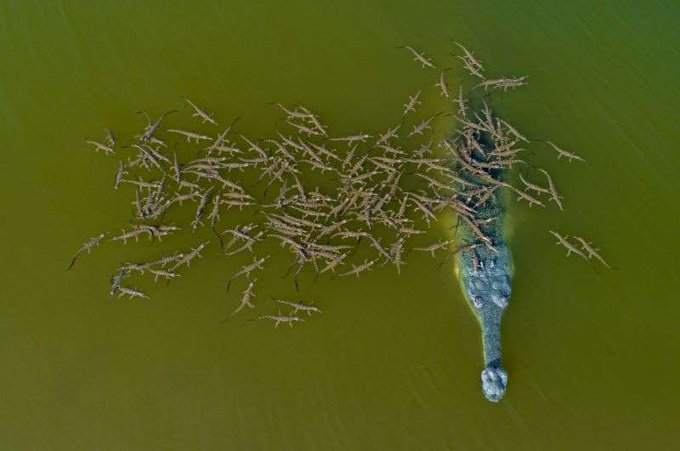
Hatchling Gharials
How hatchling gharials from multiple females congregate near the dominant male, likely their father, on the territory where they hatched, in an impressive photo taken by Dhritiman Mukherjee, among the winning entries from the 2018 Drone Awards
Thursday, November 28, 2019
Egyptian plover (Pluvianus aegyptius)

Egyptian plover (Pluvianus aegyptius)
The Plover bird gets her food and the crocodile gets his mouth cleaned. In this way, they are able to help each other.




Wednesday, November 20, 2019
Sunday, November 17, 2019
Painted Turtle Hitching a Ride on a Alligator, Florida
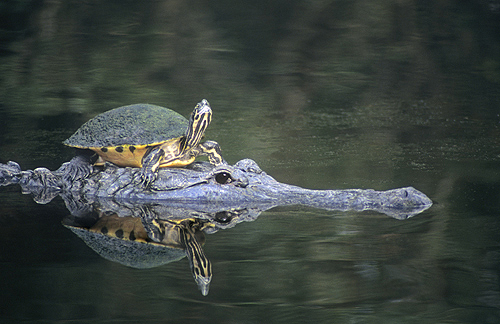
Painted Turtle Hitching a Ride on a Alligator, Florida
Monday, August 19, 2019
Big kahuna
Big kahuna
Big kahuna is an idiom that is derived from the native Hawaiian language. The word kahuna has gone through many variations in translation until it finally joined the English language in the middle of the twentieth century in the idiom the big kahuna, a term many Hawaiians find offensive.
The first known translation of the Hawaiian word kahuna appeared in an 1865 Hawaiian-English dictionary as a derivation of the word kahu, which means to cook in an earthen oven. At this time, kahuna was applied to anyone who practiced an art or profession with mastery, such as a kahuna lapa’au, or a doctor. When the word kahuna was used alone, it referred to a priest or shaman. During the mid-1800s to late 1800s, a kahuna was an expert in an art or profession. When tourists began to visit Hawaii, they were exposed to the word kahuna, especially the phrase kahuna nui he’e nalu, which means the master surfer. Eventually, the phrase was shortened and semi-Anglicized to the term big kahuna. In 1959 the term was popularized by the movie Gidget, which featured a character named The Big Kahuna, who was the ringleader of a group of surfers. Today big kahuna is a humorous term used to describe anyone who holds a position of power in an organization or is in some way important. The original meaning of kahuna encompassed a spiritual aspect, therefore, some Hawaiians are offended by the appropriation of the word. In 2004, many Hawaiians signed a petition asking Dodge not to produce a concept car aimed at surfers named the Kahuna. Though big kahuna appears in the Oxford English Dictionary, it may be best not to use this pidgin term.
Thursday, July 4, 2019
The Crocodile Hunter's son is following in his iconic footsteps
Robert Irwin shares incredible side-by-side photos of him and his dad 15 years apart
The Crocodile Hunter's son is following in his iconic footsteps. Robert Irwin shared a photo of himself feeding a crocodile named Murray, in the same place his dad fed the croc 15 years earlier, and it made fans a little emotional.
Like Tweet Message
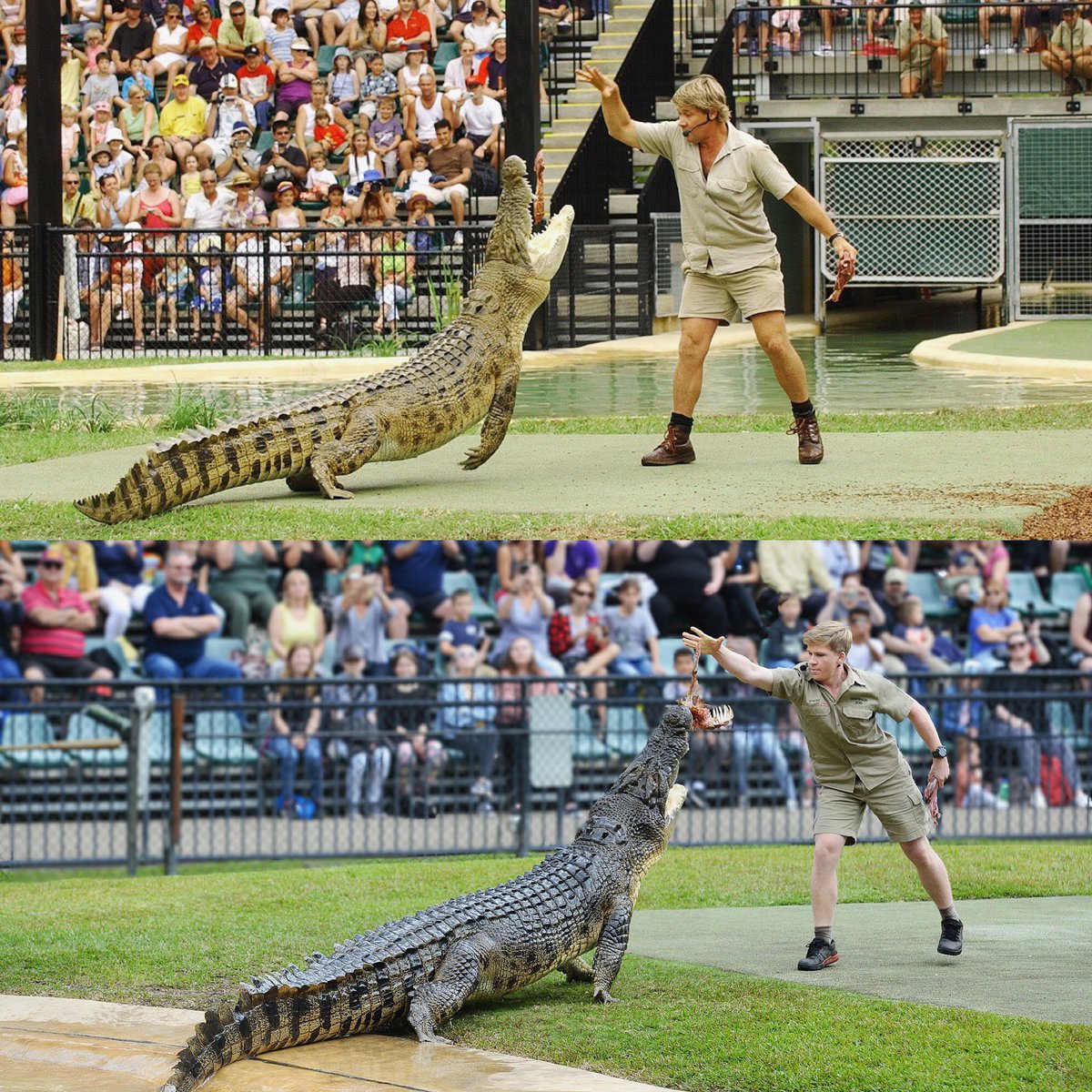
Dad and me feeding Murray... same place, same croc - two photos 15 years apart

Monday, July 1, 2019
Tuesday, April 30, 2019
Komodo Dragons could hold the key to beating Superbugs
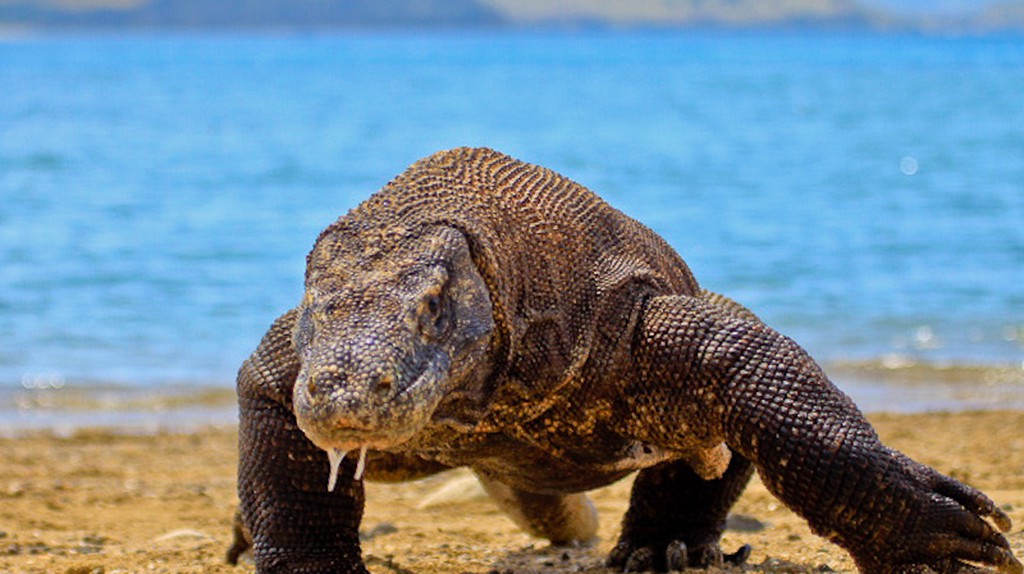
DailyMail
Wednesday, Feb 22nd 2017
DRAGONS could hold the key to beating superbugs: Komodo blood found to have 'superantibacterial' properties
DRAGONS could hold the key to beating superbugs: Komodo blood found to have 'superantibacterial' properties
- Komodo dragons have at least 57 types of bacteria in saliva, but appear resistant
- Researchers incubated Komodo dragon blood, revealing antimicrobial activity
- Discovery could help develop new drugs to fight antibiotic-resistant superbugs
By Cheyenne Macdonald For Dailymail.com
Published: 22 February 2017
They’re the largest lizards in the world, with deadly saliva that’s loaded with at least 57 species of bacteria to bring down their prey.
And, according to new research, the blood of Komodo dragons could be the key to developing new drugs in the fight against antibiotic-resistant superbugs.
The team used a method known as ‘bioprospecting,’ revealing antimicrobial protein fragments in their blood that protects them against infections.
They’re the largest lizards in the world, with deadly saliva that’s loaded with at least 57 species of bacteria to bring down their prey. And, according to new research, the blood of Komodo dragons could be the key to developing new drugs to fight antibiotic-resistant superbugs
THE GROWING THREAT OF SUPERBUGS
Antibiotic resistance occurs when bacteria change to 'outsmart' or resist antibiotic medicine, making it close to impossible to treat the infection.
The bacterium that carries resistance genes to many different antibiotics is called a superbug.
Most of these infections occur in hospitals or in medical care facilities, such as nursing homes.
The Centers for Disease Control and Prevention said that more than two million people are infected with antibiotic resistant bacteria every year.
More than 23,000 people die from these infections each year.
Experts say that if the epidemic is not brought under control, superbugs may kill more people than cancer by the year 2050.
In the study, researchers from the College of Science at George Mason University investigated whether they could isolate substances known as cationic antimicrobial peptides from Komodo dragon blood – massive lizards the dwell on five small islands in Indonesia.
These CAMP substances are an essential part of the innate immune system, and the team had previously done this with alligator blood.
In a technique called bioprospecting, they incubated the Komodo dragon blood with negatively charged hydrogel particles that they developed to capture the positively charged peptides.
This allowed the researchers to identify and sequence 48 potential CAMPS with mass spectrometry.
All of these, except for one, was derived from histone proteins.
These types of proteins are known to have antimicrobial activities.
The researchers then synthesized eight and tested them against Pseudomonas aeruginosa and Staphylococcus aureus.
The antibiotic resistant strain of S. Aureus (MRSA) is a growing problem worldwide.
The analysis revealed that seven of the peptides from the Komodo dragon blood were potent against both of the bacteria.
The eighth peptide was only effective against P. aeruginosa.
The researchers then synthesized eight and tested them against Pseudomonas aeruginosa and Staphylococcus aureus. The antibiotic resistant strain of S. Aureus (MRSA) is a growing problem worldwide
It’s thought that the bacteria in Komodo dragons’ saliva helps them to kill their prey.
But, the dragons themselves appear to be resistant.
According to the new research, serum derived from the animals may have antibacterial abilities as well.
This could pave the way for new therapeutics to treat antibiotic resistant bacteria.
‘The study demonstrates the power and promise of our bioprospecting approach to cationic antimicrobial peptide (CAMP) discovery and it reveals the presence of a plethora of novel h
‘These findings may have broader implications regarding the role that intact histones and histone-derived peptides play in defending the host from infection.’
Komodo Dragons Are Complicated Killers

Komodo Dragon
Zoo Dragon
Komodo National Park in Indonesia Is One of the World's Finest Treasures
EDIRA PUTRI
19 JUNE 2017
Komodo National Park comprises three islands—Komodo Island, Padar Island, and Rinca Island—and numerous surrounding smaller islands.
Komodo National Park comprises three islands—Komodo Island, Padar Island, and Rinca Island—and numerous surrounding smaller islands.
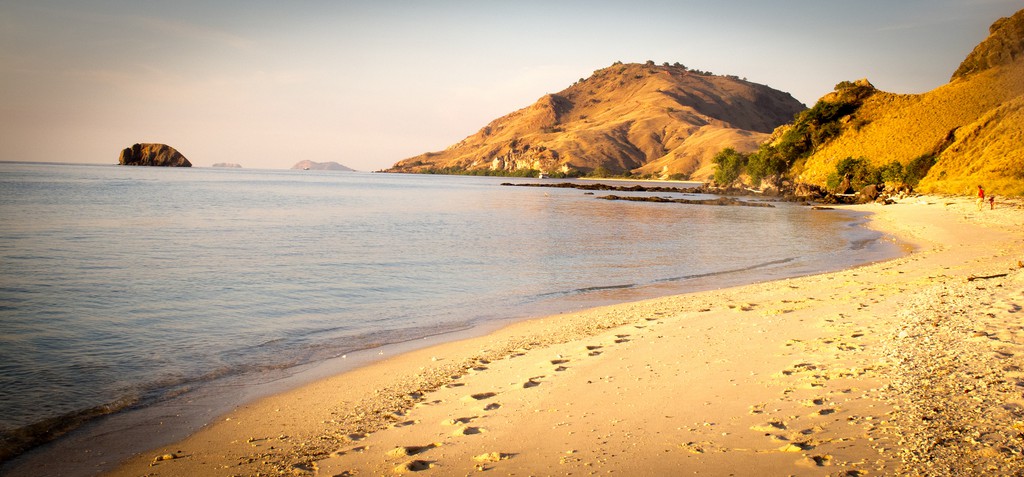
A beach at Komodo National Park
The park’s importance is acknowledged by global organizations such as a UNESCO World Heritage Site in 1991. WWF and Conservation International have recognized the place as a global conservation priority area. The park’s status as one of the 'New 7 Wonders of Nature' has established its global significance.
Komodo Dragons can only be found on five islands in the world, four of which are part of the national park, plus the nearby Flores Island in East Nusa Tenggara.
Komodo Dragons can only be found on five islands in the world, four of which are part of the national park, plus the nearby Flores Island in East Nusa Tenggara.
According to scientists, this particular species has managed to survive for millions of years, making it one of the oldest species that still exists today.
Many scientists believe that the otherworldly Dragons are close relatives to the dinosaur, from the same era and showing similar bodily structure. Thus, Komodo Dragons are often called “the last dinosaur in the world.” The species is the largest living species of lizard, with an average length of 2-3 meters.

The mighty Komodo Dragon
The national park's distinctive natural environment combines a nutrient-rich ocean water and volcanic elements, which have made it possible for thousands of different species to thrive in and around the islands. As many as 1,000 species of tropical fish, 260 species of coral, 70 species of sponge, as well as endemic species like the orange-footed scrub fowl, the Timor deer, Rinca rat, turtles, dolphins, and dugongs.
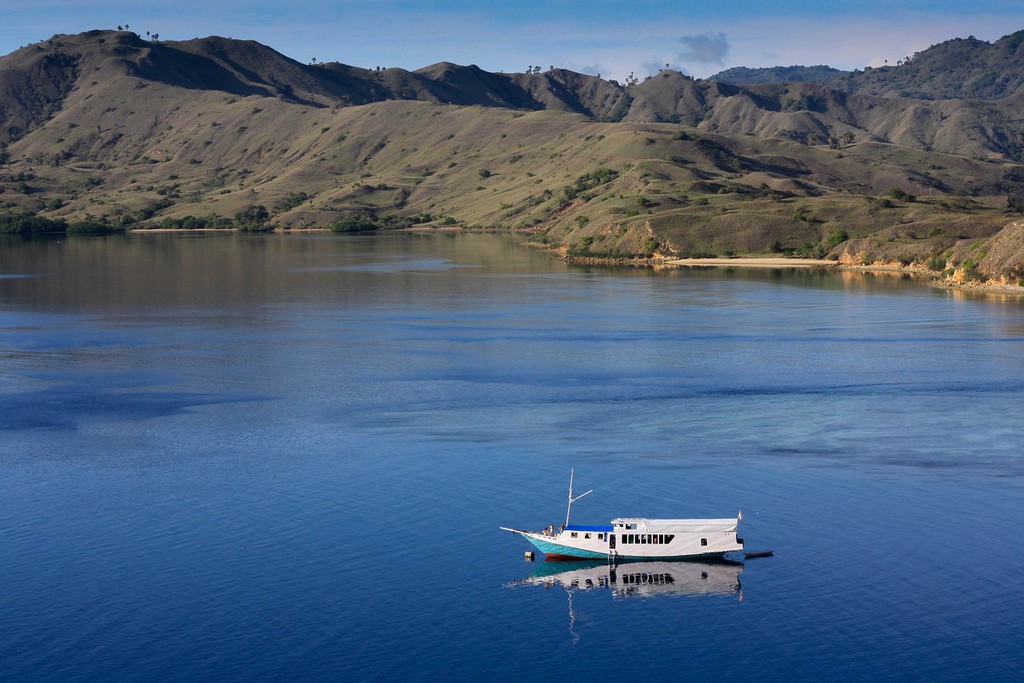
The blue sea of Komodo National Park, Indonesia
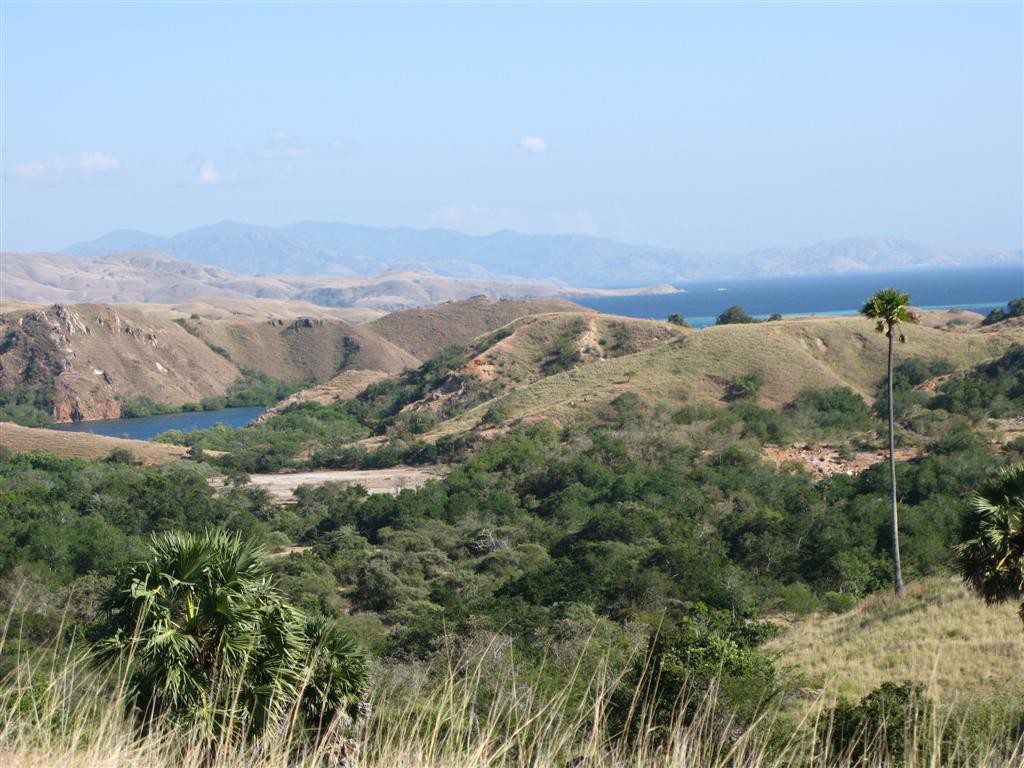
The view at Komodo National Park, Indonesia
Facts about the Komodo Dragon
• They can run up to 20 kph.
• When a baby Komodo dragon hatches it burrows out of its dirt mound of a nest and makes for the nearest tree to stay until it grows up. It must make it to the tree before its mother sees it or she will eat it. Up in the tree it stays living on insects, lizards, birds and anything else that has the misfortune of landing there until it is too heavy to stay on a branch. They are camouflage grey/brown, so hard to see them in the trees, or on the ground.
• There are over 2,200 dragons on the 390 sqm Komodo island and two other islands nearby. They are also all micro-chipped. To do that risky job, one lures them into a cage with raw meat and jabs the chip in.
• Locals believe that it’s the toxic bacteria in Dragon saliva that kills, but a scientific study by the University of Melbourne in 2009 dispelled that and proved that there is venom in their saliva. If the prey manages to get away it soon collapses and dies and the dragon can feast on it later. It's hard to survive their sharp teeth and deadly claws.
Link: https://theculturetrip.com/asia/indonesia/articles/why-the-komodo-national-park-in-indonesia-is-one-of-the-worlds-finest-treasures/
Largest Lizard on Earth | The Komodo Dragon | Deadly 60 | Indonesia | Series 3 | BBC
Published on Feb 14, 2014
SUBSCRIBED 4.2M
Steve Backshall travels to Indonesia in search of reptiles to add to his list of 60 deadly predators. He and his crew have a nerve-racking close encounter with three metre long Komodo dragons, the world's largest venomous lizards!
Komodo Dragons Kill With Venom, Researchers Find
BY CAROLYN BARRY
Dispelling what one expert calls a scientific fairy tale, a new study shows that the fierce lizards ooze venom, not toxic bacteria, into bites to help weaken and ultimately kill their prey.
In the venom, some compounds that reduce blood pressure are as potent as those found in the word's most venomous snake, western Australia's inland Taipan.
Komodo Combo Attack
While his colleagues expressed surprise at the findings, Fry said he wasn't so shocked.
His earlier research had shown that other lizard species—such as iguanas, legless lizards, and monitor lizards—are also venomous.
His earlier research had shown that other lizard species—such as iguanas, legless lizards, and monitor lizards—are also venomous.
In fact, Fry estimates that close to a hundred of the more than 5,000 known lizard species use venom.
What is surprising, Fry said, is Komodo dragons' elaborate venom-delivery system.
"It's the most complex duct system described in reptiles to date," he said.
"It's the most complex duct system described in reptiles to date," he said.
Snakes typically have a single venom duct that leads to their fangs. But Komodos have multiple ducts located between their teeth.
However, this means Komodo dragons don't deliver their venom as efficiently as snakes, Fry said.
However, this means Komodo dragons don't deliver their venom as efficiently as snakes, Fry said.
Rather than injecting venom directly via a forceful bite, the dragons use a specialized bite-and-pull motion to ooze the toxin into wounds during a sustained, frenzied attack.
"They're not like the cobra, where venom is the only game in town. Komodos have a combined arsenal," Fry said.
The findings suggest that the Komodo's ancient relative, the Megalania, used a similar venom-plus-wounding approach.
The giant lizard, which roamed Australia about 40,000 years ago, measured about 13 feet (4 meters) long.



Komodo dragons fight over a kill

Steve Irwin

Steve Irwin
Sunday, April 28, 2019
Croc eats keeper
Scientist snatched, eaten alive by giant crocodile during feeding
By Gerard du Cann, The Sun
January 15, 2019
ORIGINALLY PUBLISHED BY:
A scientist was eaten alive by a 17-foot long crocodile after being dragged into its enclosure while she fed it on Friday.
Deasy Tuwo, 44, was feeding the croc named Merry early on Friday morning at the CV Yosiki Laboratory in Indonesia when the beast appears to have reared and leaped up an 8-foot-high concrete wall, pulling her into the water.
Tuwo, the head of the lab which reportedly made beauty products, was found by her coworkers at around 8:45 a.m. that day, after they noticed a “strange shape” in the water.
The reptile was found lying on the ground with Tuwo’s savaged body in its jaws.
It had ripped off Tuwo’s left arm and mutilated her upper torso.
Merry had previously killed another croc that shared its pool, and staff said it was known to be a troubled animal.
Rescue workers battled to retrieve the woman’s remains from the croc, which thrashed violently every time they tried to fish the corpse from the water.
Police said they did not know why the croc was kept near the lab, and they could not find the Japanese owner to ask him.
The reptile was finally captured and restrained on Tuesday, strapped to a flat-bed truck, before it was transported away for medical tests to confirm whether he had eaten any body parts.
Former colleague Merry Supit said: “She was the head of the lab. A quiet person. We’re confused about how this happened.”
Another co-worker, Erling Rumengan said: ”We were curious when we looked at the crocodile pool, there was a floating object, it was Deasy’s body.”
“We were afraid to touch it and we immediately reported the incident at the Tombariri police station.”
“It’s possible the crocodile jumped from the side. Maybe it’s because the crocodile was still full, it didn’t finish eating her body.”
The crocodile will be taken to a wildlife rescue center where tests will be carried out on its stomach.
Police said they were trying to trace the owner of the crocodile after the incident.
A Japanese businessman, who also opened the research facility, is believed to be the creature’s owner.
Police said he was not at the center at the time of the incident and had not been seen or heard from since the news broke.
Police chief said: “We are still looking for the owner of the crocodile, besides that we have coordinated with the authorities in the area.”
“I believe the owner must acknowledge this horrible incident.”
“We also need to know if he is legally permitted to own crocodiles and other expensive aquatics in his company.”
“If there is no permit, he will be detained.”
FILED UNDER: ANIMALS , CROCODILES , INDONESIA , SCIENTIST
Thursday, April 25, 2019
Thursday, April 11, 2019
Rhino Poacher Killed by Elephant and Eaten by Lions

A lion at Kruger National Park in South Africa, where the remains of a man who officials said was poaching rhinos in the park were found last week.
CreditCreditJerome Delay/Associated Press
Rhino Poacher Killed by Elephant and Eaten by Lions, Officials Say
By Christopher Mele
April 7, 2019
A man suspected of being a rhino poacher was killed last week by an elephant and his remains devoured by a pride of lions at a South African park, officials said.
Rangers at Kruger National Park and other searchers found only a human skull and a pair of pants, the park said in a statement on Friday.
Four of the dead man’s accomplices were arrested, the authorities said.
The man’s accomplices told his relatives that they had been in the park to poach rhinos on Tuesday night when he was killed by an elephant, local officials said.
A search party, including rangers on foot and members of the park’s air wing, searched the area that was described by the family but could not find the body because light was fading, the statement said. Searchers found the remains on Thursday morning.
The managing executive of the park, Glenn Phillips, offered his condolences to the family of the dead man, who was not identified.
“Entering Kruger National Park illegally and on foot is not wise,” he said in the statement. “It holds many dangers and this incident is evidence of that.”
Mr. Phillips said it was sad to see the daughters of the man “mourning the loss of their father, and worse still, only being able to recover very little of his remains.”
Kruger National Park advertises itself as offering “an African safari adventure of a lifetime.” At nearly two million hectares, it is the largest national reserve in South Africa, according to its website, which added that it was home to animals such as lions, elephants, rhinoceroses, leopards and African buffaloes.
Last July, rangers and police officers said that as many as three men suspected of being rhino poachers had been killed by lions at a South African game preserve.
Rhino horn is worth about $9,000 per pound in Asia, driving a lucrative and illicit trade. It is a prized ingredient in traditional Chinese medicine and is considered a status symbol.
“It’s one of the most expensive wildlife products on the illegal market and that’s why these poachers go after it,” Michael Slattery, founder of the Texas Christian University Rhino Initiative, said on Sunday. “The current prices for a rhino horn are anywhere from $15,000 to $50,000 a kilogram. They are seeing dollar signs. It is more expensive than gold and cocaine, so the demand is driving these poachers.”
South Africa is home to about 20,000 wild rhinos, more than 80 percent of the world’s population. About one-third of the animals are owned by private breeders.
Since 2008, more than 7,000 rhinos have been hunted illegally, with 1,028 killed in 2017, according to the South African Department of Environmental Affairs.
The poachers can get more money if they can deliver a complete rhino horn, but to get a full rhino horn they have to kill the animal, Professor Slattery said. Poachers drug the rhinos and then use a machete to “hack away at the face,” he said. The rhinos then bleed to death.
A rhino horn, which is made of 100 percent keratin, or the equivalent of compressed hair, provides no health benefits to humans.
Still, people grind up the horn and use it in a drink in a misguided effort to reduce fevers and cure hangovers, among other things. Rhino horns are also given as gifts, Professor Slattery said.
“That equation pretty quickly tips over to these animals disappearing before our eyes,” he said.
Sandra E. Garcia contributed reporting.
Subscribe to:
Posts (Atom)









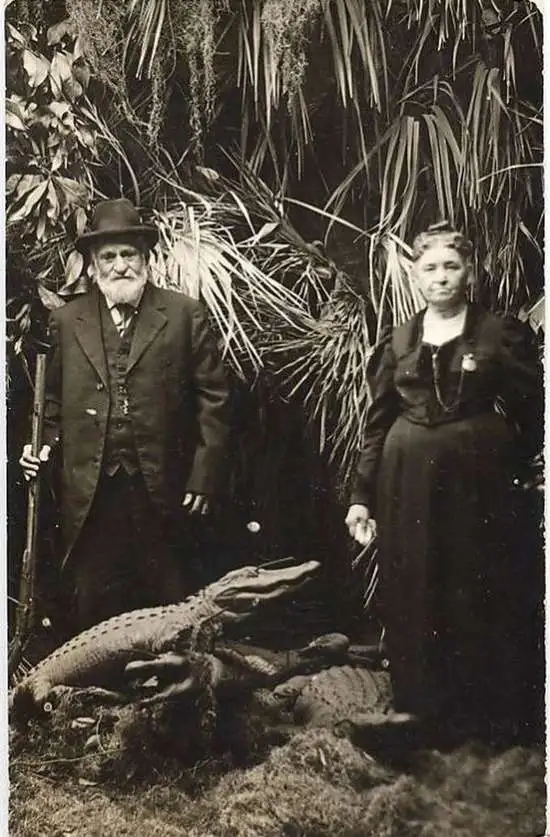
 Terri IrwinVerified account
Terri IrwinVerified account
